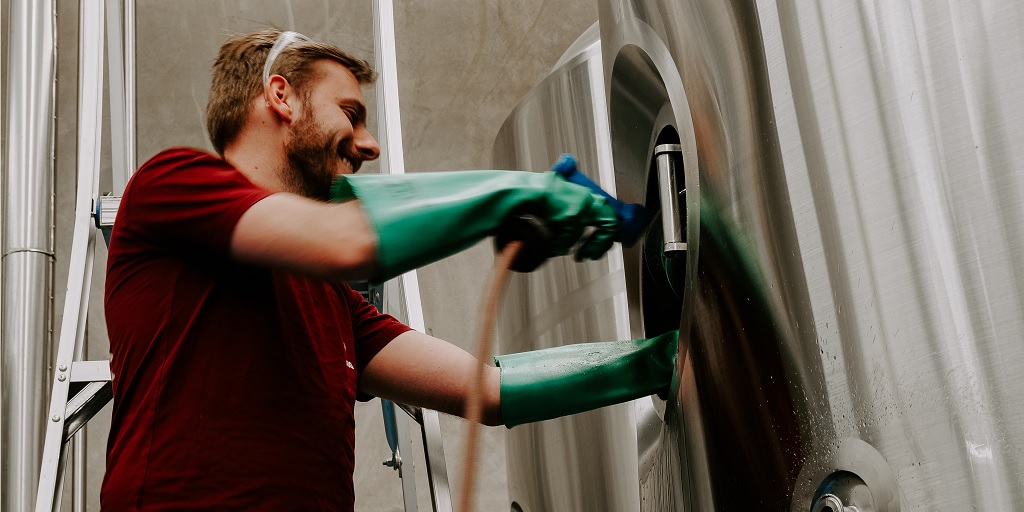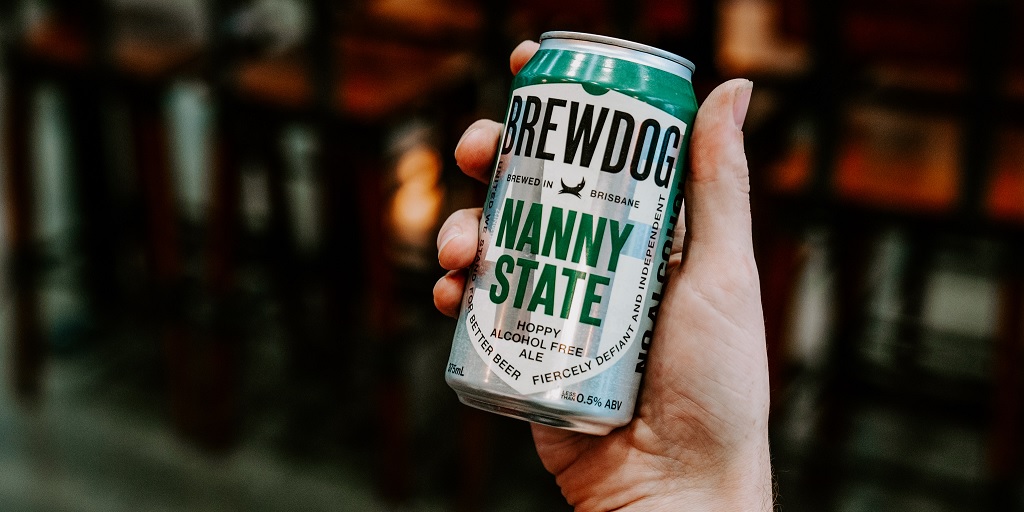
BrewDog adds pasteuriser to expand NoLo range

Tim Radjenovic, new head brewer at BrewDog Australia.
BrewDog Australia has brought in a new pasteuriser as it looks to expand its range of no and low-alcohol options.
The new Alfa Laval flash pasteuriser is able to process between 20-40hL of beer per hour and will be fully commissioned next month.
“The plan is to use it for all our alcohol-free beers, just for the fact once you take alcohol out, it’s not as safe,” said BrewDog’s new head brewer Tim Radjenovic.
“It also allows us to back sweeten or when we’re adding lactose for body, and you don’t want that extra sugar or sweetener in there because it obviously gives yeast something to eat.
“Killing that means you’ve got endless opportunities to experiment with alcohol-free beers.”
Radjenovic has replaced former head brewer Linsday Crawford who moved to NSW last month to be closer to family following the pandemic restrictions, taking a role at Hawkesbury Brewing Co.
Radjenovic has been with the business since November 2019, having previously worked at 4 Pines Brewing Co. where he worked with Crawford, and then at All Hands Brewing Co. in Sydney, which was subsequently taken over by 4 Pines.
“We haven’t bought it for anything other than low and now alc,” explained Ed Bott, BrewDog’s general manager for Australia.
“If you do [those beers] you have to pasteurise. Being able to pasteurise it and getting tested as well, gives us flexibility to experiment with alcohol-free and shandies, and the pasteuriser gives us that ability to pack in cans and kegs too.”
BrewDog pasteuriser
Pasteurising has been a contentious issue in the brewing industry. The stigma has even led some brewers in the craft space being reluctant to discuss their methods for creating zero alcohol beer.
“Historically, the brewing process wasn’t as good as it is now. They always had microbe problems so it made sense to pasteurise, but as brewing has gotten better, people still see it as a case of ‘if you need to pasteurise to have beer, you have bad processes’,” said Radjenovic.
“That’s the stigma behind it – you could have shelf-stable beer but pasteurising is an insurance policy. For us we’re just using it for alcohol-free and low beers.”
“If you talk to any of the major NA beer producers, they pasteurise all the way, because it’s too risky otherwise.
“But it’s two different conversations. Pasteurising ‘normal’ beer, there is potentially a stigma, born out of 30 years of people like Greg Koch saying he wouldn’t pasteurise.
“For us, we have the right equipment to be safe [with NA beers] and everything else is standard kit.”
However it’s not a ‘one-size-fits-all’ for BrewDog operations, and BrewDog does not currently pasteurise its Nanny State beers in Australia, but gets batches micro tested.
“It’s an old recipe and alcohol-free tastes have moved on a little bit from that space.
“Nanny State is not back sweetened, so it has a small fermentation, there’s only up to 0.5% alcohol in it, but we send that away for micro testing at the moment.”
Globally, Bott explained, BrewDog pasteurises its Punk IPA in Germany due to its refillable and returnable bottle system.
“We’ve never hidden behind it, we pasteurise Punk IPA in Germany in the refillable bottles there because the risk is too great otherwise. Our first priority has to be safety for consumers. It’s true that it has a stigma, but if there’s a risk attached [it’s the right thing to do].”
BrewDog has pasteurisers in the United States and Britain, but they chose a flash pasteuriser over a tunnel pasteuriser for practical reasons.
“It’s a lot more efficient, tunnel pasteurisers are power and water-intensive, you pretty much heat water and pump it around,” said Radjenovic.
Learning from global operations
One of the greatest benefits of being part of an international group is the sharing of knowledge.
In the US, BrewDog began brewing alcohol-free beers two years ago.
“I think we’re one of the biggest alcohol-free breweries in the US and it’s been the primary growth engine for the brewery in America. We’re in the top 50 breweries in America in terms of size, and we’re the fastest growing and that’s driven by the fact we’re investing in alcohol-free.”
Head of quality at BrewDog USA, Cooper Asay, has sent over beers for the Australian team to take inspiration from.
“They’re doing a lot of experimenting, and with low alcohol you have to try different methods to get different flavours. They’ve tried out pretty much every single US hop at different pHs,”explained Radjenovic.
“They are in a position to make good alcohol free beer, and we have all that information available to us and it puts us in a good position to learn from that.”
Conventionally, no-alcohol beers are supplemented and attempt to replicate the body of an alcoholic beer through the use of lactose, but in the US, BrewDog is experimenting with fruit extracts instead. But the US experiences are also helping with the direction its Australian counterpart wants to take.
“Based on our Punk IPA, and using knowledge from America to do an AF version of a hazy, and the fruited sour Cooper sent over we loved the most as well,” Bott said.

Bringing back shandies
The US is a more mature market in terms of alcohol-free options compared to Australia, and that’s something BrewDog is aware of despite the capital investment in equipment.
“We have to be careful to not get ahead of ourselves,” reasoned Bott.
“It would be silly to put five different ones in cans straight away. We’re being careful, we’ve got Nanny State which we will pasteurise when we have it up and running, but it won’t be the same demand as a 5% pale ale.”
To bridge this gap between alcohol-free and alcoholic beers, BrewDog is looking at other options, namely shandies, previously considered an old-fashioned option.
“Beer mixers have a role to play, not sure why it’s never cracked a market like Queensland, with its high temperatures and humidity,” said Bott.
“Great Northern and midstrength beer has dominated the market, in my brain there’s a role for a 2.5% abv super refreshing shandy.
“Seltzers have taken off over the last year or so, everyone drinking mid-strength, there’s a whole gap in beer for it.
“I would unashamedly make shandies new again, and we’re experimenting this year with a classic 50/50 with natural lemonade, we want it to be lemony primarily.”
The beer industry has become adept at making old trends new again, and re-marketing them, and the shandy could be the next to get this revitalising treatment, with radler beers already a popular post-sports drink in places like Germany.
“It’s old fashioned, and there was a bit of a renaissance of radlers, but not in the general population.
“There’s a real stigma around shandies in craft beer – “don’t you ever put lemonade in the beer” – but we’ve moved on from those macho days, and craft has moved on from that.
“Everyone’s taste buds are their taste buds, no one is wrong. If we can do it, and it’s enjoyable to craft beer drinkers and others, that’s something we want to do.
“You can do some really good quality drinks which hit that sweet spot, pardon the pun.”
Shandies do have a precedent in BrewDog. BrewDog Scotland brought out a one-off edition, but with the lack of shandies in the market, it also means BrewDog will be forging ahead with seltzers, ginger beer and kombucha as its nearest comparisons.
“It’s an entirely different duty category and it will be at a different price point,” said Bott.
“But ultimately the judge will be, how does it taste? Do people like the taste? If it’s a struggle in terms of taste it will be a struggle to sell.”
Hear more about BrewDog AU on the Beer is a Conversation podcast with Ed Bott.



